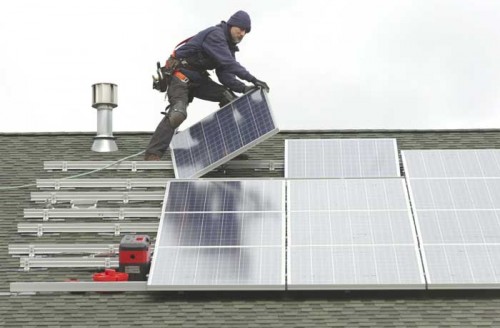Going solar: panels on Institute building will cut energy costs

Published in the Courier-Times on March 23, 2010 by Ralph Schwartz
SEDRO-WOOLLEY The Park and Forest Information Center sits on prime real estate, near the intersection of Highway 20 and Highway 9. It also happens to be a prime location for solar power.
“I have a building that is facing due south with no shade or anything,” building owner Keith Earnst said, recounting his decision late last year to go solar.
Earnst’s building, the visitor center for the Mount Baker-Snoqualmie National Forest and North Cascades National Park [and the administrative headquarters of North Cascades Institute], has a new and conspicuous feature. Local contractor Whidbey Sun & Wind installed 140 solar panels on the building’s roof earlier this month. They will generate enough electricity to power two and a half homes. The U.S. Forest Service and the National Park Service say solar energy aligns with their green agenda.
For Earnst, the motivation was more financial than environmental, although he said that if going solar meets the federal agencies environmental needs, then maybe they’ll be more inclined to lease from him long term. “I think the cost of electricity is going to keep rising. It makes a lot of sense down the road to do this,” Earnst said.
The solar panels will generate about 14 percent of the power for the building, according to the Park Service. An array this big can also reduce the building’s carbon output by 50 tons per year, said Chris Carbonella, operations manager for Whidbey Sun & Wind. “North Cascades National Park just completed its Climate Friendly Park Action Plan. As part of that effort, the park inventoried its greenhouse gas emissions in 2009. It’s great that this (solar installation) is going to be reducing the energy consumption,” North Cascades National Park Facility Operations Specialist Kerri Cook said. “The best benefit from the Park Service’s perspective is, it’s going to raise people’s awareness of renewable energy sources,” she said.
The highly visible installation on Highway 20 is by far the biggest for the Coupeville-based business Carbonella works for.
“This (project) is such a good example for Whidbey Sun & Wind that this is a viable solution for all,” Carbonella said. Earnst would agree on the solution’s viability. He expects to get the maximum state incentive payment of $5,000 per year for his solar installation. Adding this to the money he saves by using less power from the grid, and the credits he earns from Puget Sound Energy for adding power to the grid, Earnst’s energy costs can be reduced by 40 percent, the Park Service said.
With all these returns, Earnst’s investment could pay for itself in about 12 years, depending on the amount of sunlight that shines on his building. Carbonella speaks highly of the potential for the rainy Pacific Northwest to be an efficient place for solar power. “Power generation is almost as good here as it is in Southern California,” he said. “The days are longer here, the air pollution is thinner and the temperatures are ideal.”
“Above 77 degrees, … efficiency drops significantly,” Carbonella said. With a U.S. president and a state governor who are both supportive of alternative energy, the regulations are also stacked in solar power’s favor. The federal government offers a tax credit for solar energy, and the state gives a sales-tax exemption on top of the $5,000 incentive payment.
Also, the city’s approval of the building permit was straightforward, allowing the plan to go from initiation to construction in two months. The panels were installed in nine working days. PSE was expected to install a meter to allow power generation to begin early this week. Carbonella believes not just the sun but all the stars are aligned for growth among businesses like his.
“We’re going to see a better market for photovoltaics,” he said. “Everybody’s starting to think green. It’s not becoming out of the norm, it’s becoming the norm, which is good.”

